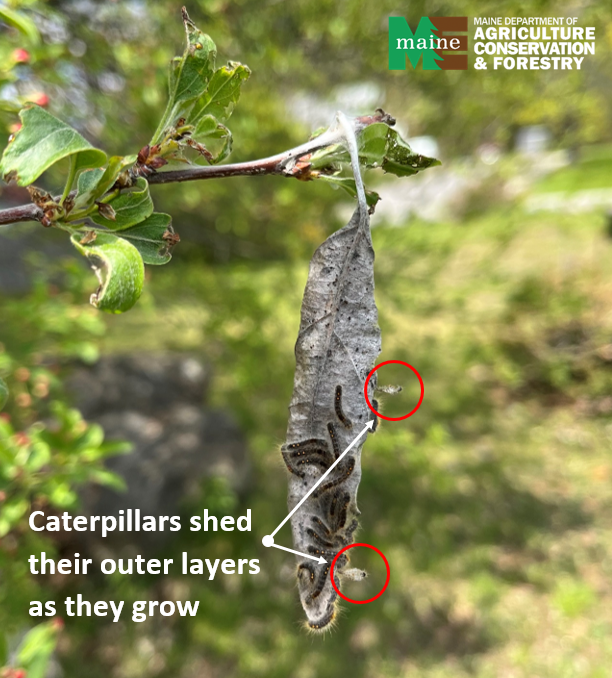Browntail Moth Update #4: May 12, 2023
We've had some wonderful sunny and warm weather this past week; which means that many browntail moth host plants have been continuing to produce leaves and flower buds. However, this also means that there is more food available for hungry browntail caterpillars. With this in mind, it may not be surprising that we documented the caterpillars nearly doubling in size at almost all of our monitoring sites. Their growth at this time of the year is expected and is related to the caterpillars' increased metabolism and appetite. Each time a caterpillar grows larger, they have to shed the outer layer of their bodies (exoskeleton), a process called molting. Oftentimes, caterpillars will eat these old outer layers, but sometimes you can see the old outer layers on their winter web. As the caterpillars grow, they will molt a few more times, and therefore will have more toxic hairs on their bodies. Please take caution while performing outdoor yardwork near trees that have browntail caterpillars to avoid contracting a rash from the toxic hairs - wear long sleeves, eye protection, and gloves.
 |
During the molting process, caterpillars grow too large for their current outer layer (exoskeleton). Because the exoskeleton cannot grow with the caterpillar, the caterpillar sheds this outer layer, which can be seen in this photo. Skowhegan, ME.
As we mentioned in last week's update, eastern tent caterpillar is a native caterpillar that often gets confused with browntail caterpillar. At this time, both species of caterpillars are building their silk tents right now. Eastern tent caterpillar webs start small in the 'crook' of the tree where the branch meets the trunk or where branches join together. These tents can grow quite large, reaching around the size of a football. Right now, the eastern tent caterpillar tents are roughly the size of an adult hand and the white silk is much denser than browntail silk tents. Remember, browntail tents always stay on the smaller side and are often on the tips of the tree branches.
So far, we have not found evidence of any pathogens causing disease in browntail caterpillars at our monitoring sites. Some signs of pathogens may be:
- White/yellow fungal spores on caterpillars
- Swollen, puffy caterpillars
- Liquid expulsion of the caterpillar guts (often the caterpillar rests in an upside-down "V" shape)
- Dead caterpillars
See the photo below for examples of browntail caterpillars with pathogens present. We will continue to be on the lookout and we welcome your reports as well.
Browntail caterpillars with pathogens that cause mortality. Photo credit: E. Groden at University of Maine.
Where is Browntail Moth in Maine?
Maine Forest Service conducts surveys for browntail moth from small planes and from moving trucks. These are broad-scale surveys that do not completely cover the impacted area. You can get a broad idea of where browntail moth is in Maine from our interactive map, just updated with 2023 winter web surveys. To understand what browntail moth is up to in a specific area take a look at host plants for webs and signs of caterpillar activity.
Browntail Moth Mitigation Fund - Update
The Request for Applications (RFA) for the Browntail Moth Mitigation Fund is open through May 16. The fund was established to provide support to government entities or non-profit organizations in areas with significant browntail populations to reduce impacts from browntail moth. Only applications from government entities or non-profit organizations will be considered; funding is not available for individuals. The Division of Procurement Services Grant RFP/RFA page will have updates as soon as they are available. We will also include information in these bulletins.
|